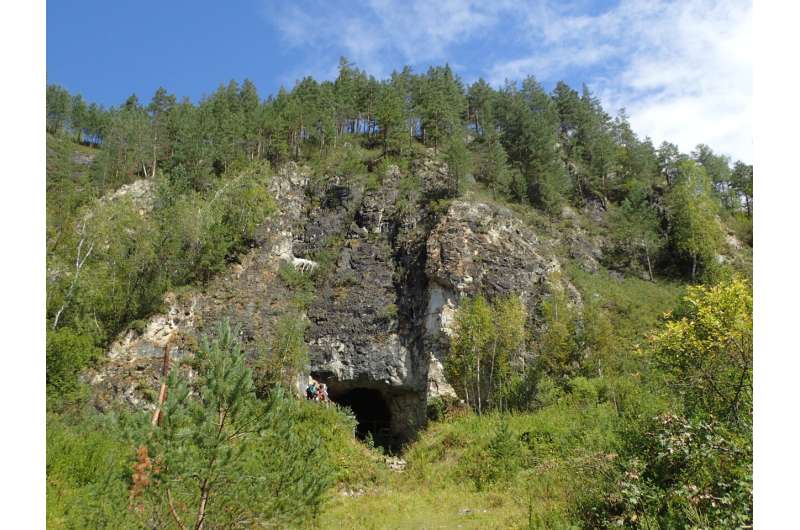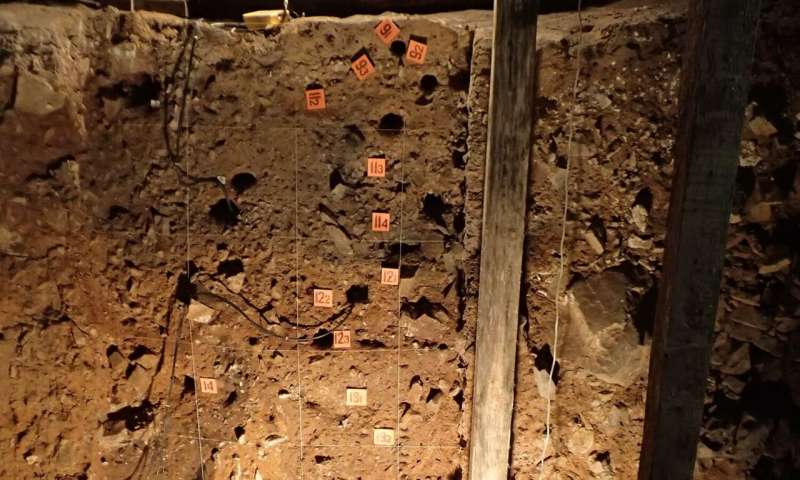Pleistocene sediment DNA from Denisova Cave


Max Planck researchers have analyzed DNA from 728 sediment samples from Denisova Cave. Their study provides unprecedented detail about the occupation of the site by both archaic and modern humans over 300,000 years. The researchers detected the DNA of Neandertals and Denisovans, the two forms of archaic hominins who inhabited the cave, and—for the first time—the DNA of modern humans who appeared around the time of the emergence of an archaeological culture called the Initial Upper Paleolithic around 45,000 years ago.
Denisova Cave is located in the Altai Mountains in southern Siberia and is famous for the discovery of Denisovans, an extinct form of archaic humans that is thought to have occupied large parts of central and eastern Asia. Neandertal remains have also been found at the site, as well as a bone from a child who had a Neandertal mother and Denisovan father, showing that both groups met in the region. However, only eight bone fragments and teeth of Neandertals and Denisovans have been recovered so far from the deposits in Denisova Cave, which cover a time span of over 300,000 years. These are too few fossils to reconstruct the occupational history of the site in detail, or to link the different types of stone tools and other artifacts found in Denisova Cave to specific hominin groups. For example, the discovery of jewelry and pendants typical of the so-called Initial Upper Paleolithic culture in approximately 45,000-year-old layers has prompted debates as to whether Denisovans, Neandertals or modern humans were the creators of these artifacts.
Michael Shunkov of the Siberian Branch of the Russian Academy of Sciences, who leads the excavations at Denisova Cave, assembled an interdisciplinary team of archaeologists, geneticists, geochronologists and other scientists to study this unique site. The team has now performed the largest analysis ever of sediment DNA from a single excavation site.
“The analysis of sediment DNA provides a wonderful opportunity to combine the dates that we previously determined for the deposits in Denisova Cave with molecular evidence for the presence of people and fauna,” says Richard “Bert” Roberts from the University of Wollongong in Australia. The team of geochronologists led by him and Zenobia Jacobs collected more than 700 sediment samples in a dense grid from the exposed sediment profiles in the cave. “Just collecting the samples from all three chambers in the cave, and documenting their precise locations, took us more than a week,” Jacobs says.
When the samples arrived at the Max Planck Institute for Evolutionary Anthropology in Leipzig, Elena Zavala, the lead author of the study, spent another two years in the lab to extract and sequence small traces of ancient hominin and animal mitochondrial DNA from this huge collection of samples. “These efforts paid off and we detected the DNA of Denisovans, Neandertals or ancient modern humans in 175 of the samples,” Zavala says.

When matching the DNA profiles with the ages of the layers, the researchers found that the earliest hominin DNA belonged to Denisovans, indicating that they produced the oldest stone tools at the site between 250,000 and 170,000 years ago. The first Neandertals arrived towards the end of this time period, after which both Denisovans and Neandertals frequented the site—except between 130,000 and 100,000 years ago, when no Denisovan DNA was detected in the sediments. The Denisovans who came back after this time carried a different mitochondrial DNA, suggesting that a different population arrived in the region.
Modern human mitochondrial DNA first appears in the layers containing Initial Upper Paleolithic tools and other objects, which are much more diverse than in the older layers. “This provides not only the first evidence of ancient modern humans at the site, but also suggests that they may have brought new technology into the region with them,” says Zavala.
The scientists studied animal DNA and identified two time periods where changes occurred in both animal and hominin populations. The first, around 190,000 years ago, coincided with a shift from relatively warm (interglacial) conditions to a relatively cold (glacial) climate, when hyaena and bear populations changed and Neandertals first appeared in the cave. The second major change occurred between 130,000 and 100,000 years ago, along with a shift in climate from relatively cold to relatively warm conditions. During this period, Denisovans were absent and animal populations changed again.
“I believe that our Russian colleagues who excavate this amazing site have set the standards for many future archaeological excavations with their careful collection of many samples from each archaeological layer for DNA analysis,” says Svante Pääbo who initiated the study with the Russian team. “Being able to generate such dense genetic data from an archaeological site is like a dream come true, and these are just the beginnings,” says Matthias Meyer, the senior author on the study. “There is so much information hidden in sediments—it will keep us and many other geneticists busy for a lifetime.”
Source: Read Full Article